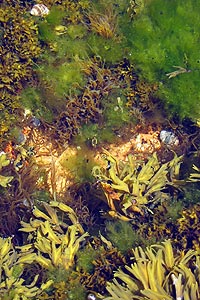 |
| NPS/Todd Edgar | | Tidepools contain hardy, fascinating marine animals. |
 |
Exploring the zone where the ocean meets land—the intertidal zone—can be a fascinating way to spend some time. Here you can see creatures with amazing survival skills that allow them to stay alive when, twice each day, the tide leaves them exposed. Barnacles, mussels, sea stars, anemones, and sometimes even crabs or young lobsters are found in the intertidal zone. While you may not see anything at first, observe quietly for a few minutes; you'll be surprised at all of the activity you see.
Before you head out to the intertidal zone on your own, check the Beaver Log from June through October for a tide chart. The best times for tidepooling are the extreme low tides of the full and new moons (“spring” tides). If you have young children, the gravel bar that connects Bar Island to Mount Desert Island in Bar Harbor, off Bridge Street, offers the easiest access. The bar is accessible about 1½ hours on either side of low tide. Other locations include Ship Harbor and Wonderland on the west side of Mount Desert Island. Be careful, as rocks may be slippery; check the tidepool tips below for safety and etiquette.
You can also explore the intertidal zone on a ranger-led program. In June, September, and October, park rangers present the Life Between the Tides program at Ship Harbor. In July and August, the Beyond the Beach program offers a chance for hands-on discovery of marine life from the comfort of Sand Beach. Check the Schedule of Events for times.
Tidepool Tips
Remember that these marine animals are not indestructible. Our careless handling and footsteps can do damage that the changing tides cannot. When you visit the intertidal zone, keep in mind these tips for your safety and for the protection of marine life:
- Do not wade or sit in tidepools.
- Rocks and algae are slippery. Watch your step.
- Never turn your back on the ocean: rogue waves can occur at any time.
- Wear suitable clothing and closed-toe shoes.
- Sea creatures live everywhere. Be careful where you place your feet.
- If you move animals or rocks, return them to the same spot.
- Do not pry animals from rocks; you may injure them in the process.
- Re-cover animals you find under rocks or seaweed so they won’t dry out.
- All living creatures are protected in the park. Take only pictures.
|






